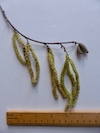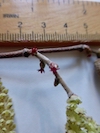| |
Hazel
(Corylus avellana) |
Simple
Roundish Alternate Toothed Abrupt point |
Simple
Roundish Alternate Toothed Broadest at tip |
|
|
|
The alternate leaves are almost round but broadest near the tip which is often drawn out into a narrow point. They are 5-12 cm long, markedly double-toothed on the margins, softly hairy on both sides and with fewer than 8 pairs of veins. The leaf stalks are short, 8-15 mm. ID check
Facts
|
|||
Return to Index Page








